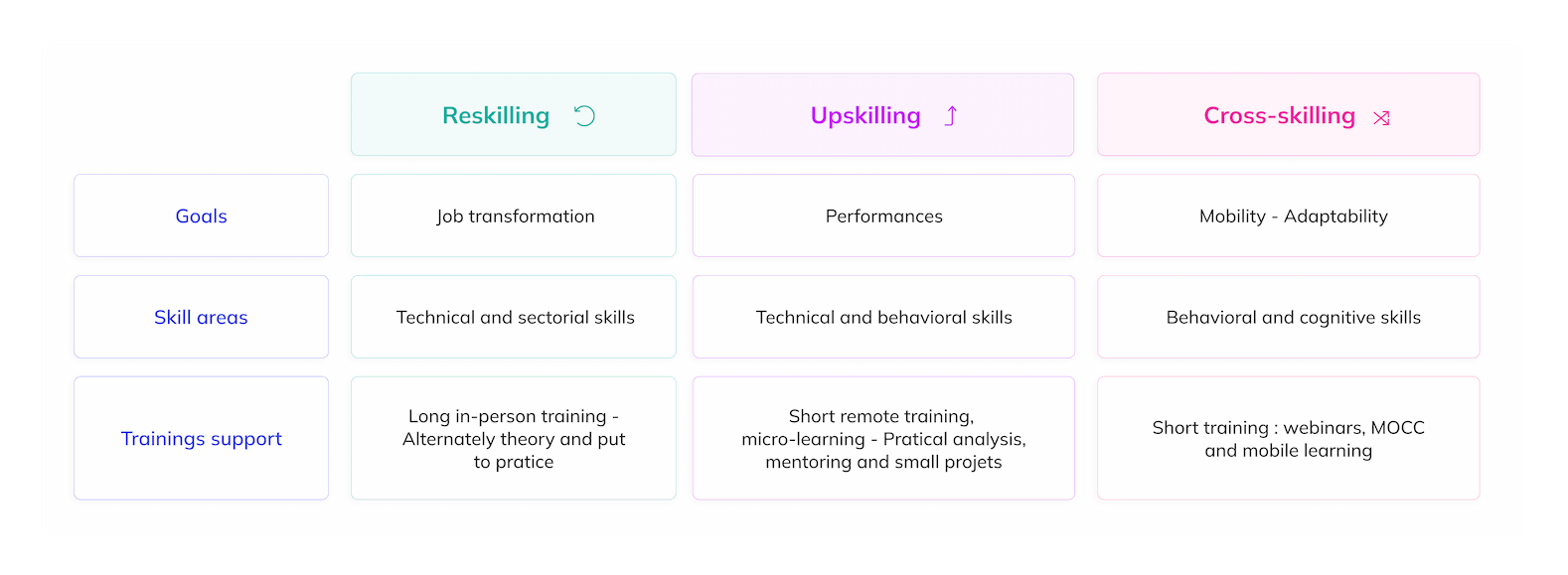INSEE estimates that young workers will change jobs between 4 and 10 times in their career. While 85% of these jobs do not yet exist, capturing new opportunities to develop one’s employability is more essential than ever. In this context, training at skills is changing form to become continuous and targeted and thus respond to the acceleration of changes experienced in each company.
How to capitalize on all these new opportunities?
What is skills advancement?
Skills advancement is a structured process designed to help employees acquire the skills they need to become more autonomous and effective. These skills may be entirely new, or they may represent an extension of know-how already applied on a day-to-day basis. Developing employees’ skills and skills is part of an HR policy that not only concerns talents and high potentials, but is also part of the Jobs & Skills Management framework.
Why is there an urgent need for skills upgrading today?
Many factors explain the acceleration of the need to scale up skill. PWC cites task automation in one report. This factor is important but insufficient to explain what we have summarized in 5 major factors:
- The energy or ecological transition
- Digital transformation
- Artificial intelligence and the redeployment of resources to non-automated tasks
- The primacy of data and the thirst to master uncertainty
- Virtual reality and more broadly the internal and external relations to the company
The increasing significance of these factors in skill development necessitates the alignment of objectives with current training frameworks.
What are the various opportunities for skill advancement?
Depending on the context of the training (strategic project to be carried out, need for increased performance, business transformation or professional mobility) the opportunities will be different: it is either "upskilling", "reskilling" or "cross-skilling".
Let’s look at each of these opportunities:
Upskilling: an opportunity to increase performance
It’s training to perfect your skills in a particular field. The basic skills skills have already been acquired by the individual, but offering them permanent employability requires a variety of training courses that respond to the needs of different professions and the way in which they evolve. The areas of skills where the training effort is most present are :
- The skills techniques around the use of digital tools
- The skills mixed sectorial and technical that adapt the uses of data and artificial intelligence to a particular field
- The skills behavioral to develop soft skills around collaboration in particular
Which Upskilling devices to choose?
- The short distance format with many repetitions like microlearning is suitable.
- The analysis of practices, mentoring and involvement in projects allows a rapid rise in skills.
Interested in the latest development opportunities? Our Page on immersive training discusses the opportunity of Metavers in training.
Reskilling: an opportunity to make a career change and move up the career ladder skills
It is the training of professionalization or maintenance in the job, often used in a situation of transformation of the activity of the company. Indeed, whether the situation is desired or not, the skill to be acquired will condition either the new job or the maintenance of the existing job.
To illustrate our point, our customer Sage has led a change of business model to evolve into a Software As A Service.
This movement has required the identification of changing professions, a mapping of current and new skills and, as a result, significant support to adapt employees to the new professions. Here is the video testimony of the People Director.
Which Reskilling devices to choose?
- The preferred training is longer, with priority given to the face-to-face format for the transfer of skills.
- The alternation of theory and practical application often leads to certification.
Cross-skilling: an opportunity to adapt quickly
It is a matter of training to broaden one’s scope of action and to adapt more easily to new tasks. This search for versatility is also accompanied by the objective of limiting risks in the event of a rapid change in activity. This HR development policy needs to be considered on the scale of a fairly large population. It offers an excellent understanding of all of the company’s businesses and interactions facilitated by the creation of skills .
This form of training now focuses more on skills behavioral skills to support the values of the company. It can also take the form of a recruitment strategy to overcome shortages of skills. In this case, the company recruits individuals with natural predispositions to acquire various skills for several occupations.
Which cross-skilling devices to choose?
- Gamification formats that involve the confrontation of ideas between members contribute effectively to learning.
- They are accompanied by short formats such as webinars, Mooc or mobile learning.
How do you choose the right training materials for your skills advancement plan?
Today, we can say that training is no longer a problem given the multitude of educational content that can be found in a few clicks on the Internet, whether free or paid. This is a very good thing, but it also means that you have to target the training courses according to your needs:
- skills that you wish to acquire (the category of training: digital, wellness, entrepreneurial path…)
- Learning preferences (independent, group, mentored)
- Format (video, audio / podcast, ebook)
Also, the Professional Future Law adopted in September 2018 reorganizes the world of professional training and thoroughly reforms unemployment insurance and apprenticeship. French employees are increasingly opting for the CPF (Professional Training Account), exceeding 2 million training courses in one year.
This realization is a result of the Covid crisis as well as the massive deployment of telecommuting. On the one hand, employees have become aware of the importance of self-training and they also have the feeling that there are many sources of development. Most often included in LMS platforms, knowledge acquisition methods (face-to-face, mentoring, micro-learning, virtual reality, etc.) are varied and place the employee in the driver’s seat of his or her career path.
Skill Advancement: What impacts do they have on employees and on the organization?
The annual interview, which takes place once a year, allows for the detection of new skills skills to be acquired, and to become aware of them. This is where the training and the systems put in place by the company take on their full meaning.
Indeed, the objective is to fill the gaps of skills identified, to train on the skills of the future and to meet the requirements of the Management of Jobs and Professional Careers (Jobs & Skills Management).
Training has a dual impact:
- The first is individual, as it allows the employee to go further, to accomplish himself and to develop his potential. This can be for several categories of skills : technical, behavioral, cognitive or sectoral.
- The second is collective, as it allows the group, and even the company as a whole, to progress. Training also allows for internal mobility of the employee based on his or her aspirations. For the company, it means financial savings, a cultural adhesion that has already been acquired, a greater chance of success compared to external recruitment, and a strengthening of the employer brand.
Conclude on skills upgrading
The variety of up-skilling schemes skills is growing in response to the many uncertainties that companies are experiencing. Whether it is a question of performance, adapting to changes in professions, a desire to change career paths, or flexibility, employees and HR training teams are collaborating enthusiastically. For the latter, the challenge is to shorten the time between the evolution of market constraints, the detection of the necessary skills and the adaptation of skills , while measuring the adaptations made.
Our Page “AI and Talent Management” provides an overview of quick solutions to implement.
Since the Loi Avenir Professonnel in 2018, and then the Covid crisis in 2020, training opportunities are plentiful. The CPF eligibility of online training courses has increased their visibility, thanks to partial or total coverage depending on the amount contributed.
Finally, the diversity of skills is also the guarantee of the diversity of profiles in an organization. Avoiding clones of an organization is synonymous with better adaptation to the uncertain environment, enhanced creativity and more rational decision making.
The next step is to measure the Return on Investment of your training plan, our “Training Budget Optimization“page will help you in this process.








